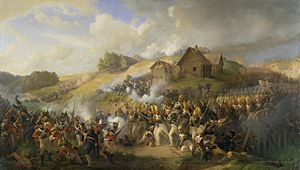Battle of Klyastitsy facts for kids
Quick facts for kids Battle of Klyastitsy |
|||||||
|---|---|---|---|---|---|---|---|
| Part of the French invasion of Russia | |||||||
 Battle of Klyastitsy, by Peter von Hess |
|||||||
|
|||||||
| Belligerents | |||||||
| Commanders and leaders | |||||||
| Strength | |||||||
| 17,000 (30–31 July) 23,000 in total 108 guns |
20,000 engaged 28,000 overall 114 guns |
||||||
| Casualties and losses | |||||||
| 4,300 killed or wounded | 3,700 killed or wounded | ||||||
The Battle of Klyastitsy was a series of important fights that happened from July 30 to August 1, 1812. These battles took place near a village called Klyastitsy in the Russian Empire. It was a key part of Napoleon's French invasion of Russia.
In this battle, the Russian army, led by generals Yakov Kulnev and Peter Wittgenstein, faced off against the French army, commanded by Marshal Nicolas Oudinot. Both sides suffered many losses. In the end, the Russian forces won a small victory, managing to capture the village of Klyastitsy. The French army then pulled back, and the Russians chased them.
Contents
What Happened in the Battle
The Start of the Fight: July 30
On July 30, 1812, French cavalry groups were surprised by a sudden attack. Eight Russian cavalry groups, made up of Hussars and Cossacks, attacked them. These Russian forces were led by General Yakov Kulnev.
At this time, Marshal Oudinot's French army had taken over the village of Klyastitsy. They were on their way to attack St. Petersburg. The French had about 28,000 soldiers, while the Russian army had 17,000. Even though the Russians had fewer soldiers, General Wittgenstein decided to fight.
The battle began at 2:00 PM on July 30. General Kulnev's Russian advance group, with about 4,000 men, fought the French advance group all day. This fight happened near a village called Yakubovo. Kulnev's troops pushed the French hard, but the French managed to hold onto the village.
Crossing the River: July 31
The next day, July 31, there were many attacks and counterattacks. The Russian army kept pushing forward. This forced Marshal Oudinot to retreat back to Klyastitsy. To keep moving forward, the Russian troops needed to cross the River Nishcha.
Oudinot ordered his soldiers to set fire to the only bridge over the river. While some Russian cavalry soldiers were wading across the river, a brave group from the Pavlovsk Grenadier Regiment rushed across the burning bridge. This daring moment was captured in a famous painting by Peter Hess.
The Final Push: August 1
General Kulnev continued to chase the French army with several cavalry groups and one infantry group. However, on August 1, after crossing the Drissa River, his unit fell into a trap. French artillery fired on them, causing many losses. Sadly, General Kulnev was badly wounded and died that same day.
Despite this loss, General Wittgenstein finished the battle with a victory. Marshal Oudinot's forces retreated to Polotsk. This meant that the French army's plan to advance on St. Petersburg had failed.
What Happened After the Battle
General Wittgenstein was given a high honor, the Order of St. George of the Second Degree, for his leadership. It is said that Emperor Alexander I called him "the savior of St. Petersburg." Captain Krylov, whose unit was the first to cross the burning bridge, also received an award, the Order of St. George of the Fourth Degree.
See also

